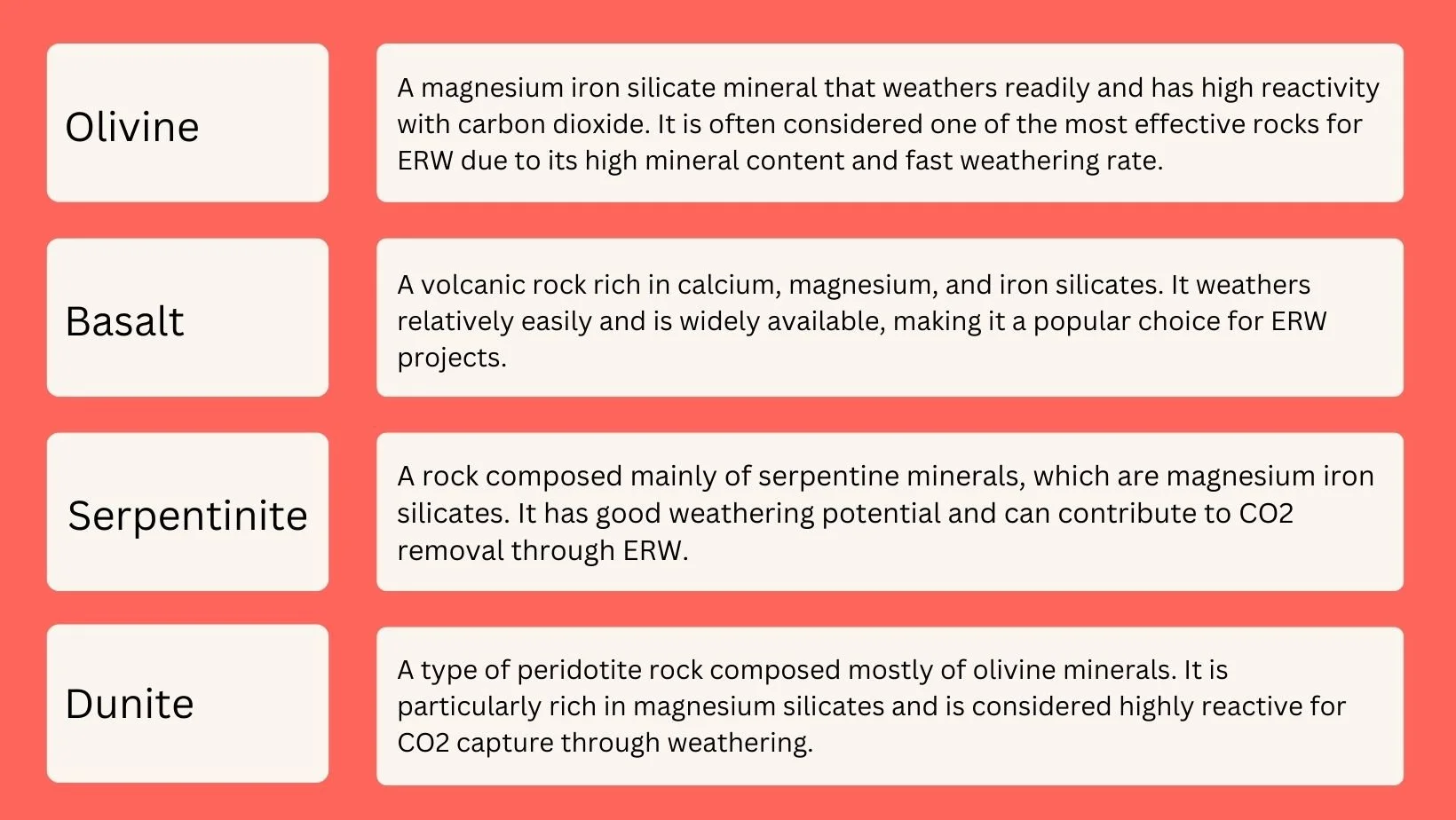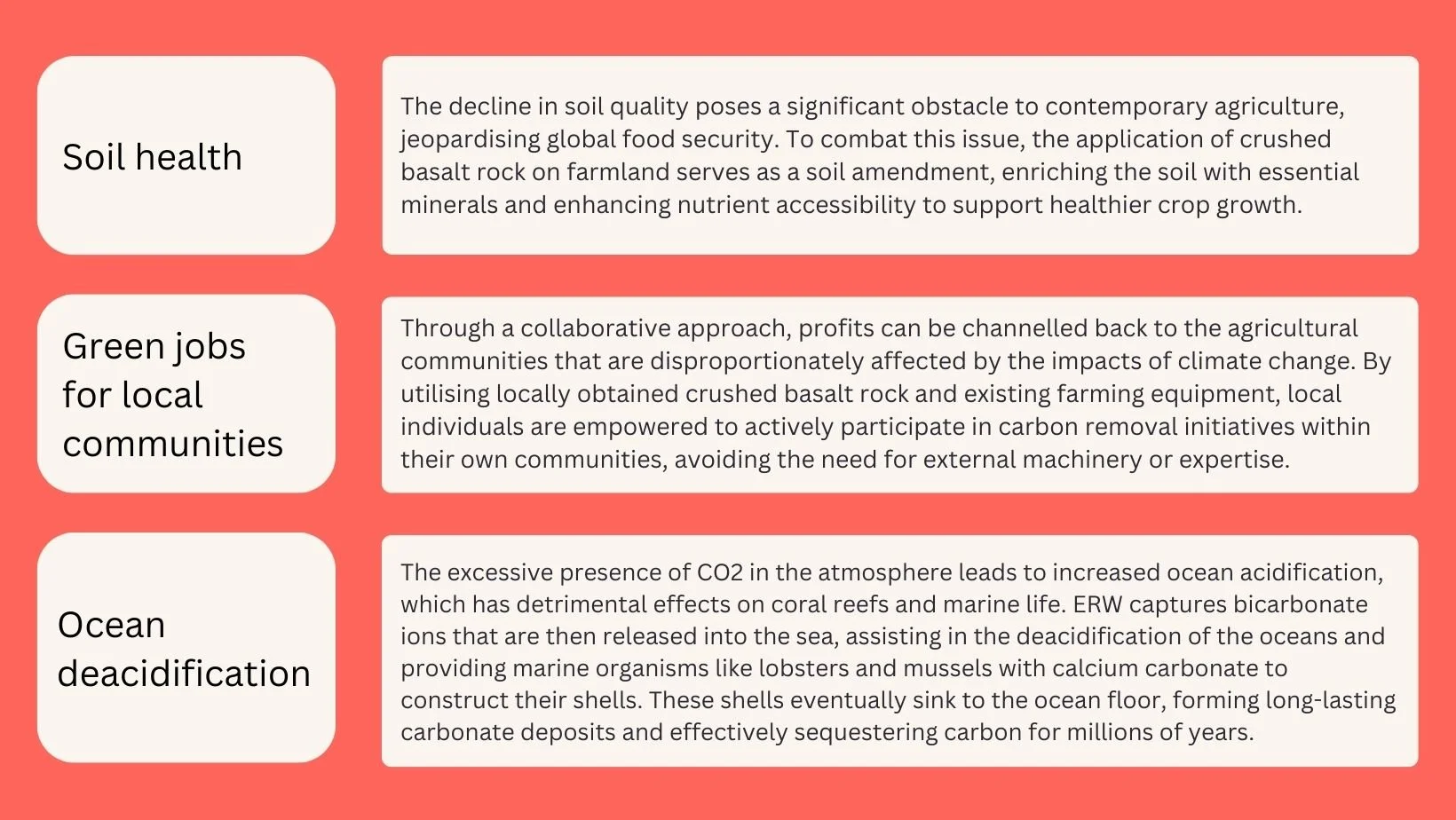School of Rock: unearthing the potential of enhanced rock weathering
In this series of blogs, Kita offers an insight to the variety of carbon removal and emissions avoidance project types contributing credits to the VCM. We describe the carbon removal technique, relate the ways in which the methodology operates within the carbon market, outline the potential risks involved and highlight the ways in which insurance can reduce the risk profile and contribute to progress for the approach in question.
Our aim is to demystify these methodologies and clarify their position within the VCM. We hope that greater transparency and understanding of carbon removal technologies helps to increase confidence and drive investment towards these projects.
In this post we consider enhanced rock weathering (ERW).
What does Enhanced Rock Weathering do?
Chemical weathering is a natural process that continuously erodes the rocks in our landscapes and sequesters atmospheric CO2 over millions of years. Enhanced Rock Weathering (ERW) is a technique for mitigating climate change by harnessing the natural process of weathering to remove carbon dioxide (CO2) from the atmosphere. It involves grinding rocks into fine particles and spreading them over large areas like agricultural fields or coastal regions. When these rock particles come into contact with the air and rainwater, a series of chemical reactions occur that lead to the dissolution of minerals and the release of elements like calcium, magnesium, and iron. As a result, CO2 from the atmosphere reacts with these elements to form stable carbonate compounds, effectively storing the carbon in a solid, long-lasting form. It can be implemented in terrestrial, coastal, and aquatic environments.
A variety of rocks can be used for ERW, but the most commonly considered rocks are silicate minerals. Silicate rocks contain minerals rich in silicate compounds, such as calcium, magnesium, and iron silicates. Some examples of rocks commonly used for ERW include the below:
These rocks are crushed or ground into fine particles to increase their surface area and enhance their interaction with carbon dioxide. The choice of rock depends on factors such as availability, reactivity, cost, and suitability for specific project locations. Different ERW projects may employ different rock types based on their specific requirements and circumstances.
ERW offers a series of climate benefits. Firstly, it directly removes CO2 from the atmosphere, acting as a negative emissions technology. Secondly, the dissolved minerals enhance soil fertility, promoting healthier plant growth and increasing agricultural productivity. Third, the alkaline nature of the process can counteract soil acidity, reducing the need for synthetic fertilisers and further decreasing greenhouse gas emissions associated with their production.
Moreover, ERW has the potential to be implemented on a large scale and in various geographical locations. It can be integrated with existing land use practices, such as agriculture or forestry, minimising additional land requirements. Additionally, the abundant availability of suitable rock types makes it a widely accessible solution.
How do ERW projects relate to the carbon markets?
ERW carbon projects and credits play a vital role in the carbon markets by offering a unique approach to carbon dioxide removal and climate change mitigation.
ERW carbon credits are particularly attractive due to their additional co-benefits as they create more value, making them an attractive option for buyers. Alongside CO2 removal, the dissolution of minerals in ERW can improve soil fertility, enhance agricultural productivity, and potentially reduce the need for synthetic fertilisers. See table below for the three main co-benefits derived from ERW:
While reforestation is crucial for biodiversity, it only temporarily locks up carbon, as trees have a limited lifespan and face risks such as wildfires and deforestation. In contrast, ERW securely stores carbon dioxide for over 100,000 years, ensuring long-term carbon sequestration. Engineered solutions like direct air capture (DAC) provide high permanence but require substantial energy for machinery construction and operation, resulting in increased fossil fuel consumption. Moreover, DAC lacks significant co-benefits. ERW combines the advantages of both natural and technological solutions, delivering permanent, rapid, and scalable carbon removal with 95% efficiency.
Much like other technologies, ERW has clear benefits. However, to effectively address the climate crisis, all carbon removal methods including reforestation, direct air capture, biochar, ocean-based approaches, and ERW must be deployed simultaneously and on a large scale.
Industry insights and experts:
UNDO is a UK-based project developer specialising in ERW. Their approach involves utilising finely crushed basalt rock, which is derived from the quarrying and mining sectors, and applying it to farmland to expedite the natural process of rock weathering. In May 2023, the company raised $12 million (led by Lowercarbon Capital and AENU) to help scale up its ERW operations.
For emerging solutions like ERW there are often no existing verification standards, due to their novelty. Therefore, it is crucial to assess if these early-stage projects are working towards developing their own methodology, which will undergo independent assessment and certification, or aligning with a third-party methodology under development. The methodology is essential for understanding a project's quality, as it outlines their approach and detailed carbon removal quantification. Transparent projects will readily share their methodology, ensuring accessibility for carbon buyers and demonstrating their commitment to quality.
UNDO's team has collaborated closely with Puro.earth in the development of the first ERW methodology. This announcement has opened up new possibilities for scaling up the ERW process and expanding the purchase of carbon credits generated through it.
What are the specific risks in regard to ERW projects?
The key risks associated with ERW projects are:
Additionality: Ensuring that the project activity would not have occurred in the absence of the carbon credit revenue, and that the project is making a real contribution to reducing greenhouse gas emissions.
Baseline and monitoring: Setting a credible and accurate baseline for the project emissions and monitoring the project activity to ensure that it is in line with the baseline.
Leakage: Ensuring that the project activity does not lead to increased emissions elsewhere.
Permanence: Ensuring that the carbon sequestered or avoided by the project will be permanently maintained, and not released back into the atmosphere at a later time.
Environmental and social safeguards: Ensuring that the project activity does not have negative impacts on the environment or communities, and that appropriate safeguards are in place to protect local people and ecosystems.
Can insurance help manage these risks?
Insurance can help manage risks associated with ERW projects in multiple ways:
Unavoidable risks, like natural catastrophes, can affect ERW projects. Catastrophes such as earthquakes, hurricanes, or floods can physically disrupt ERW infrastructure, including storage facilities, transportation networks, or equipment. These disruptions can hinder the sourcing, processing, and application of the silicate rocks required for ERW.
Avoidable risks, like acts of fraud or negligence by project developers, or the insolvency of the project developer, can happen in carbon projects across multiple types. Insurance can protect buyers of carbon credits against these types of challenges impacting on their carbon purchases.
Carbon risks, like reassessments to baselines or changes/invalidation of carbon standards/methodologies are broader risks factors in the carbon markets that can impact ERW projects. Insurance can perform a comprehensive assessment of the project, including risk management and compliance with standards, providing financial protection and coverage against these risks.
Technical risks such as availability and suitability of silicate rocks, as well as the effectiveness of the weathering process. There is a risk that the chosen rocks may not be readily accessible or may contain insufficient mineral content for effective carbon dioxide (CO2) capture. Insurance can perform risk assessment of the rocks chosen as well as the overall effectiveness of the weathering process.
Conclusion
ERW, like other carbon removal methods, is a relatively new technique, and many projects are still in their early stages. Therefore, substantial short-term financial investment is required to develop and scale up these projects to effectively remove significant amounts of CO2 from the atmosphere. By supporting ERW projects, a substantial impact can be made, as this technology has the potential to remove huge quantities of CO2 and play a vital role in combating climate change.
The biggest challenge in ERW is accurately measuring and quantifying the amount of carbon dioxide removed, unlike Direct Air Capture (DAC), which is metered. To ensure transparency and credibility of the carbon credits, rigorous data management systems are necessary to provide full visibility across the supply chain. This involves traceability from feedstock sourcing to end-use application.
While ERW shows great promise, further research is needed to fully understand its long-term impacts, cost-effectiveness, and potential side effects on ecosystems. Nonetheless, it plays a crucial role in our collective efforts to combat climate change, holding significant potential as a complementary strategy for climate change mitigation, alongside efforts to reduce greenhouse gas emissions and promote sustainable practices.



